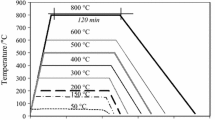Abstract
Our study was directed to the analysis of the influence of various types of cements on the behaviour of concrete at high temperatures. In our experiments binary blended and ordinary Portland cements were involved: two Portland cements with different clinker compositions and Portland cements containing pozzolanic additives as replacement of clinkers. In the first part of the study we focused on the influence of cement types where cement paste specimens were investigated. Then, based on the results of cement paste specimens, concretes specimens were prepared with some selected types of cements. Most important observation of our experimental study was that the pozzolanic additives and their increased amount have a favourable effect on the heat resistance (fire resistance) properties of concrete.








Similar content being viewed by others
References
Schneider U. Concrete at high temperatures—a general review. Fire Saf J. 1988;13:55–68.
Kordina K. Fire resistance of reinforced concrete beams, (Über das Brandverhalten punktgeschützter Stahbetonbalken), Deutscher Ausschuss für Stahlbeton, Heft 479, ISSN 0171-7197. Berlin: Beuth Verlag GmbH; 1997.
Waubke NV. Physicalise analysis of strength reduction of concrete up to 1000°C, (Über einen physikalischen Gesichtspunkt der Festigkeitsverluste von Portlandzement-betonen bei Temperaturen bis 1000°C—Brandverhalten von Bauteilen), Dissertation, TU Braunschweig; 1973.
Khoury GA. Effect of heat on concrete material. Imperial college report; 1995. p. 73.
Khoury GA, Grainger BN, Sullivan PJE. Transient thermal strain of concrete: literature review, conditions within specimen and behaviour of individual constituents. Mag Concr Res. 1995;37:48–56.
Budelman H. Strength of concrete with different moisture content after elevated temperature, (Zum Einfluss erhöhter Temperatur auf Festigkeit und Verformung von Beton mit unterschiedlichen Feuchtegehalten), Heft 76, ISBN 3-89288-016-6, Braunschweig; 1987.
Grainger BN. Concrete at high temperatures. London: Central Electricity Research Laboratories; 1980.
Khoury GA, Majorana CE, Pesavento F, Schrefler BA. Modelling of heated concrete. Mag Concr Res. 2002;54(2):77–101.
Wang HY. The effects of elevated temperature on cement paste containing GGBFS. Cem Concr Compos. 2008;30:992–9.
Poon C-S, Azhar S, Anson M, Wong Y-L. Comparison of the strength and durability performance of normal- and high-strength pozzolanic concretes at elevated temperatures. Cem Concr Res. 2001;31:1291–300.
Heikal M, El-Didamony H, Sokkary TM, Ahmed IA. Behavior of composite cement pastes containing microsilica and fly ash at elevated temperature. Constr Build Mater. 2013;38:1180–90.
Mendes A, Sanjayan J, Collins F. Phase transformations and mechanical strength of OPC/slag pastes submitted to high temperatures. Mater Struct. 2008;41:345–50.
Xu Y, Wong YL, Poon CS, Anson M. Influence of PFA on cracking of concrete and cement paste after exposure to high temperatures. Cem Concr Res. 2003;33:2009–16.
Karakurt C, Topcu IB. Effect of blended cements with natural zeolite and industrial by-products on rebar corrosion and high temperature resistance of concrete. Constr Build Mater. 2012;35:906–11.
Khoury GA, et al. Fire design of concrete materials structures and modelling. In: 1st fib congress. Osaka; Oct. 2001.
X. Yu, Y.L. Wong, C.S. Poon, M. Anson. Damage to PFA concrete subject to high temperatures. In: Proceedings of international symposium on high performance concrete-workability, strength and durability. Hong Kong; 2000. pp. 1093–100.
Nasser KW, Marzouk HM. Properties of mass concrete containing fly ash at high temperatures. ACI J. 1979;76(4):537–51.
EN 197-1:2000 Cement. Composition, specifications and conformity criteria for common cements.
U. Diederichs, U.M. Jumppanen, V. Penttala. Behavior of high strength concrete at high temperatures, Report No. 92, Department of Structural Engineering, Helsinki University of Technology; 1989.
Ghosh S, Nasser KW. Effects of high temperature and pressure on strength and elasticity of lignite fly ash and silica fume concrete. ACI Mater J. 1996;93(1):51–60.
Dias WPS, Khoury GA, Sullivan PJE. Mechanical properties of hardened cement paste exposed to temperatures up to 700 °C (1292F). ACI Mater J. 1990;87(2):160–5.
Barbara P, Iwona W. Comparative investigations of influence of chemical admixtures on pozzolanic and hydraulic activities of fly ash with the use of thermal analysis and infrared spectroscopy. J Therm Anal Calorim. 2015;120:119–27.
Yun L, Hung-Liang C. Thermal analysis and adiabatic calorimetry for early-age concrete members. J Therm Anal Calorim. 2015;122:937–45.
Stepkowska ET, Bijen JM, Perez-Rodriguez JL. Thermal mass changes of portland cement and slag cements after water sorption. J Therm Anal Calorim. 1994;42(1):41–65.
Pacewska B, Wilińska I, Blonkowski G. Investigations of cement early hydration in the presence of chemically activated fly ash. Therm Anal Calorim. 2008;93(3):769–76.
Balázs G. Építőanyagok és kémia (Buildings materials and chemistry), Műegyetemi Kiadó ISBN 944493; 1994.
Pekár G. Simple basic model for concrete and its application; 2013. http://dx.doi.org/10.14382/epitoanyag-jsbcm.2013.22.
Eurocode 1. Basis of design and actions on concrete structures. Part 2–2: actions on structures exposed to fire, EN 1991-1-2:2002; Nov 2002.
American Concrete Institute. ACI/TMS 216 standard method for determining fire resistance of concrete and masonry construction assemblies. New York: Farmington Hills; 1997.
Ministry of Construction. Ed. Taika Seinou Kenshouhou no Kaisetu Oyobi Keisanrei tosonso Kaisetu. Guideline on Vertification Method for Fire Resistance and Exemplares. Inoue Shoin; 2001.
fib bulletin 38, Fire design of concrete structures-materials, structures and modelling. ISBN: 978-2-88394-078-9; 2007.
MSZ EN 206-1:2002 concrete—part 1: specification, performance, production and conformity.
Guo X, Meng F, Shi H. Microstructure and characterization of hydrothermal synthesis of Al-substituted tobermorite. Constr Build Mater. 2017;133:253–60.
Kopecskó K. Chloride ion binding capacity of clinker minerals and cements influenced by steam curing; 2006. http://www.doktori.hu/index.php?menuid=193&vid=2743.
Acknowledgements
An OTKA-PD-109129 Grant is acknowledged. I. M. S. thanks for a János Bolyai Research Fellowship of the Hungarian Academy of Sciences. Authors acknowledge the support by the Hungarian Research Grant NVKP_16-1-0019 “Development of concrete products with improved resistance to chemical corrosion, fire or freeze–thaw”.
Author information
Authors and Affiliations
Corresponding author
Rights and permissions
About this article
Cite this article
Lublóy, É., Kopecskó, K., Balázs, G.L. et al. Improved fire resistance by using Portland-pozzolana or Portland-fly ash cements. J Therm Anal Calorim 129, 925–936 (2017). https://doi.org/10.1007/s10973-017-6245-0
Received:
Accepted:
Published:
Issue Date:
DOI: https://doi.org/10.1007/s10973-017-6245-0




